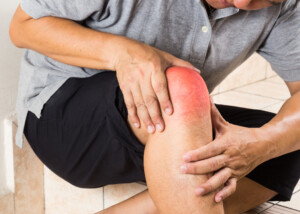
You may be aware that bursitis of the knee can cause swelling, but is this necessarily so in every single case?
“Knee bursitis may or may not result in visible or even palpable swelling,” says Devin B. Peck, MD, owner of Austin Interventional Pain in Austin, TX.
Palpable refers to detecting the swelling by feeling with your fingers, whether or not you can visually detect it.
Dr. Peck adds, “The more superficial bursae [plural of bursa], such as the prepatellar, superficial infrapatellar or pes anserine bursae, are more likely to lead to swelling that can be seen without MRI or CT scan.”
Another condition of the knee, chondromalacia patella (sometimes referred to as patellofemoral syndrome) may produce symptoms that make a person wonder if indeed the problem is actually bursitis.
The symptoms have some overlap, and chondromalacia of the patella does not cause swelling – just like sometimes, bursitis won’t cause swelling.
What to Do if Your Knee Starts Swelling
• Rest and Avoid Strain: Limit activities that put pressure on the knee to prevent aggravating the swelling.
Avoid walking long distances or engaging in strenuous activities that can worsen the condition.
• Apply Ice: Use an ice pack wrapped in a cloth and apply it to the swollen area for 15-20 minutes every 2-3 hours during the first 48 hours. This can help reduce inflammation and numb the pain.
• Elevate the Knee: Keep the affected knee elevated above heart level as much as possible. This helps reduce fluid buildup and encourages proper blood flow.
• Compression: Use an elastic bandage or knee brace to provide gentle compression.
This can help control swelling and provide support. Ensure the bandage isn’t too tight, as it could impede circulation.
• Over-the-Counter Medications: Nonsteroidal anti-inflammatory drugs (NSAIDs), like ibuprofen or naproxen, can help reduce pain and swelling.
Follow the dosage instructions on the label and consult with a healthcare provider if you have any health conditions or are taking other medications.
• Seek Medical Attention: If swelling persists for more than a few days, is severe, or is accompanied by other symptoms such as significant pain, difficulty moving the knee, or a fever, seek medical evaluation.
Persistent or severe swelling might indicate an underlying injury, infection, or chronic condition that needs professional assessment and treatment.
• Gentle Exercises and Stretching: Once the initial swelling decreases, gentle range-of-motion exercises and stretching can help restore flexibility and strength.
Consult a healthcare provider or physical therapist for appropriate exercises that won’t aggravate the condition.
 Dr. Peck’s areas of interest include chronic and acute musculoskeletal pain, sports injuries, arthritis and cancer pain, among many others. Austin Interventional Pain was established in 2019.
Dr. Peck’s areas of interest include chronic and acute musculoskeletal pain, sports injuries, arthritis and cancer pain, among many others. Austin Interventional Pain was established in 2019.
 Lorra Garrick has been covering medical, fitness and cybersecurity topics for many years, having written thousands of articles for print magazines and websites, including as a ghostwriter. She’s also a former ACE-certified personal trainer.
Lorra Garrick has been covering medical, fitness and cybersecurity topics for many years, having written thousands of articles for print magazines and websites, including as a ghostwriter. She’s also a former ACE-certified personal trainer.
.









































